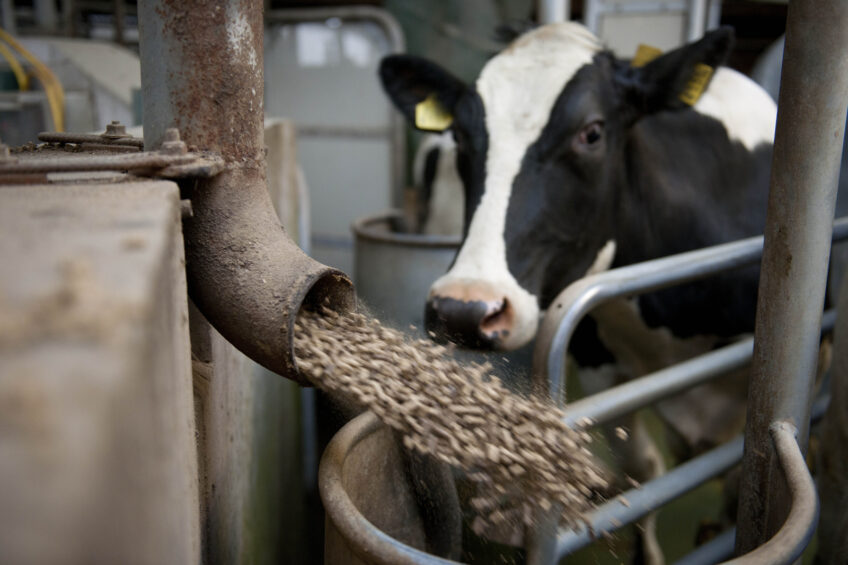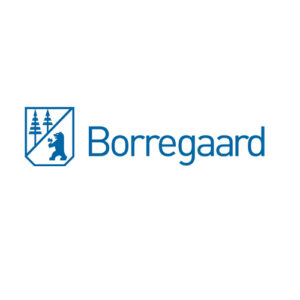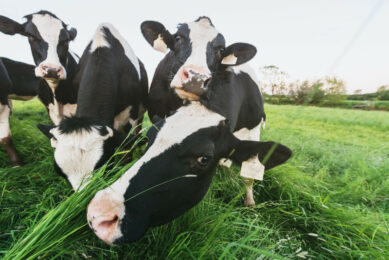Bypass protein for high producing dairy cows

Dairy cows use microbial protein, coming from the rumen, to produce a certain amount of milk. However, high producing cows need additional protein in the form of Undegradable Dietary Protein (UDP). Protein products, based on soy and rapeseed can be a cost-effective way.
In this article we describe two versions of UDP, also known as rumen protected protein supplements. One is based on rapeseed meal* (hereafter called rapeseed based protein) and the other based on soymeal** (hereafter called soy based protein). Both these products are known to have high bypass protein value and a high degree of digestibility.
The technology to produce these products was invented by Tom Winowiski, who at the time was working for Reed Lignin Inc. and assigned to the University of Nebraska in the late 80’s. His work lead to the soymeal based bypass protein, with a UDP8 (8% outflow rate) in excess of 80%, whereas some heat treatments barely achieve a UDP8 of 60%.
From protein to by-pass protein
The technology from Winowiski et al. (1987) describes the technology employed for the production of the soy based protein. “To increase the efficiency of utilising protein in feed by ruminants, feed containing a protein and a reducing sugar are mixed in quantities suitable for the Maillard reaction”. The mixture is heated at a temperature, pH and time sufficient to cause early Maillard reactions but not advanced Maillard reactions. By having an early Maillard reaction, the protein changes, so that it blocks the attachment of rumen microbial enzymes, thus preventing degradation. This is also known as the browning reaction responsible for the outer crust when baking bread and cakes that give it a sweet smelling aroma. The bond is strong and remains intact whilst in the rumen environment. On passing to the acid environment of the abomasum, pH 2 to 3 rather than the 6 to 6.5 of the rumen, the protein denatures, and starts to unwind, allowing the cow’s enzymes to get inside and break the protein down into its component amino acids that are subsequently digested and utilised for the synthesis of milk.
Type of sugar is important
The type of reducing sugar selected will determine the heating time required to form these early Maillard reactions. Borregaard has evaluated a number of reducing sugars including lactose, fructose, glucose and xylose to identify the most reactive. Xylose is proven to be the most reactive (Figure 1), and the one that occurs in sulphite liquor obtained during the pulping of timber, making this a sustainable sugar, as three trees are planted for each tree harvested. By using a highly reactive sugar the amount of heat required for early Maillard reactions to occur is less than that required for the other less reactive reducing sugars as the reaction is time/temperature dependant. Therefore, one can imagine that xylose is less likely to result in advanced Maillard reactions and indigestible protein than the use of glucose, fructose or lactose.
Figure 1 – Difference between sugars at rument protein protection after heating for 45 minutes.

Effect of heat treatment
There are a number of different bypass protein brands for ruminants. They are products of different technologies that are available globally; of these the most common is heat treatment. Fox et al. (1970) offers a technology using heat treatment to protect feed protein from degradation by ruminal microorganisms and at the same time remove heat labile growth inhibitors and bitterness of the soy bean without destroying the amino acids. The heat labile growth inhibitors contained within the initial moisture of the raw bean are released into the atmosphere so that the resultant product may be fed directly to livestock upon cooling. However, it is now thought that these heat labile growth inhibitors are deactivated by cooking and denaturing rather than evaporating them. Heat treatment reduces degradability by reducing protein solubility and by blocking sites of enzyme attack through temperature-induced chemical reactions between components of the feed. However, heat treatments to protect feed protein is a very sensitive reaction. It is now known that too little heat provides very little protection to the feed protein while too much heat creates advanced Maillard reactions that render the treated protein indigestible in the post-rumen tract. It has also been demonstrated that both cooking at high temperature and cooking for a long duration has a detrimental effect on the digestibility of the protein. Whereas, this is not so for the browning reaction employed in the production of the soy based and rapeseed based protein, as the oil seed meal/reducing sugar mix, is processed at a gentle controlled heat for a short regulated duration and pH. When this technology is applied to the oil seed extraction process, no addition heat is used other than that already present for the solvent extraction process, providing a rumen protected bypass protein with consistent UDP8 vales >80% and digestibility the same as that of soybean meal/rapeseed meal.
Amino acid ratio
It is thought that the best rumen bypass protein is one that provides amino acids (building blocks of protein) in a ratio that when combined with microbial protein and other by-pass proteins are the most similar to the ratio in milk or meat. Lapierre et al. (2011) states that in practice and with increasing research on amino acid nutrition, Lysine (Lys) and Methionine (Met) appeared to be the two first-limiting amino acids in typical diets from North America and similar recommendations for these two amino acids were proposed in the mid-90s from the laboratories of Rulquin et al. (1993) and Schwab (1996). The most recent Nutrient Requirements of Dairy Cattle (NRC, 2001), using a similar methodological approach to Rulquin et al. (1993) but with an updated database, determined that Lys and Met should represent respectively 7.08% and 2.35% of metabolisable protein (MP) supply for maximal yield of milk protein, close to the recommendations of 7.3% and 2.5% of protein digestible in the intestine (PDI) estimated by Rulquin et al. (1993). These values have since been slightly adjusted using the final version of the NRC model to predict concentrations of Lys and Met in MP (Schwab et al., 2009), with a further update and expanded database to 6.95% and 2.38% MP for Lys and Met, respectively (Whitehouse et al., 2010). The addition of the soy based protein** will provide 60 to 70% of these two limiting amino acids, where as with some heat treatments this is found to be a lot less.
Conclusion
It is the author’s view that both the technologies to produce the soy based protein and the rapeseed based protein enhance the bio availability of the nutrients in oil seed meals, in particular the limiting amino acids Lysine and Methionine. It is the customer that will ultimately decide the most cost effective product for their herd. However, when choosing a rumen protected protein, consideration should be given to the unit cost of available and digestible undegraded protein based on the purchase price and published national feeding tables. Additionally, the nutritional consistency of received consignments, which in the author’s experience, can be questionable for heat treatments employing multiple cooking processes or high temperature and sheer. This also applies to browning reactions utilising a low reactive reducing sugar.
*RaPass, ** SoyPass
References are available on request.
Join 13,000+ subscribers
Subscribe to our newsletter to stay updated about all the need-to-know content in the dairy sector, two times a week.



